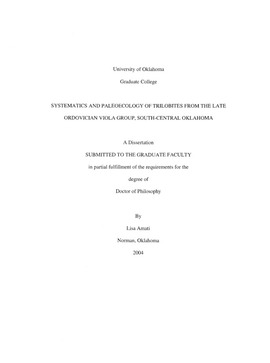| dc.contributor.advisor | Westrop, Stephen R., | en_US |
| dc.contributor.author | Amati, Lisa. | en_US |
| dc.date.accessioned | 2013-08-16T12:19:20Z | |
| dc.date.available | 2013-08-16T12:19:20Z | |
| dc.date.issued | 2004 | en_US |
| dc.identifier.uri | https://hdl.handle.net/11244/701 | |
| dc.description.abstract | The Upper Ordovician Viola Group of south-central Oklahoma records deposition on a carbonate ramp that extended from platform settings to a basin within the Southern Oklahoma aulacogen. Lithofacies analysis allows inner, mid- and outer ramp environments to be identified, each of which housed a distinct trilobite biofacies. The outer ramp Cryptolithine Biofacies is characterized by low species diversity, whereas both the mid-ramp Thaleops Biofacies and the inner ramp Bumastoides Biofacies lack cryptolithines and contain up to four times as many trilobites species. The overlying Welling Formation includes two biofacies in inner to mid-ramp environments, with the faunas of the aulacogen less diverse than those of the platform. The high trilobite species diversity in shallow-water environments of the Viola Group supports a dilution model for community reorganization during the Ordovician. Paleoecologic studies require taxonomic standardization, and this study takes the first steps toward defining relationships of three important Late Ordovician trilobite groups. Laurentian illaenid taxonomy is revised using cladistic methods. Thaleops is a large group of species whose monophyly is supported by unambiguous apomorphies. Nanillaenus is paraphyletic and is synonymized with Thaleops. Twenty-one species of Thaleops are documented, four of which are new. Eleven species of isoteline trilobites are used to correlate sections across lithostratigraphic boundaries. Six species of Isotelus, Ectenaspis, two species of Stegnopsis and two species of Anataphrus are described. The phylogenetic context of the four genera occurring in the Viola Group are discussed in terms of their relationships with closely related genera. The family Cheiruridae is represented by nine species assigned to six cheirurid genera are documented. Two species are shared with the correlative Kimmswick Limestone in eastern Missouri and Illinois, and three new species are named. The remaining species are placed in open nomenclature. The relationships of Ceraurus with the closely related genera, Gabriceraurus, Whittakerites and Borealaspis are discussed within a phylogenetic context. Leviceraurus is regarded as a junior synonym of Ceraurus and Bufoceraurus is a junior synonym of Borealaspis. | en_US |
| dc.format.extent | v, 526 leaves : | en_US |
| dc.subject | Paleontology. | en_US |
| dc.subject | Viola Group (Okla.) | en_US |
| dc.subject | Trilobites Oklahoma. | en_US |
| dc.subject | Paleoecology Ordovician. | en_US |
| dc.subject | Fossils Oklahoma. | en_US |
| dc.subject | Paleoecology. | en_US |
| dc.title | Systematics and paleoecology of trilobites from the Late Ordovician Viola Group, south-central Oklahoma. | en_US |
| dc.type | Thesis | en_US |
| dc.thesis.degree | Ph.D. | en_US |
| dc.thesis.degreeDiscipline | Conoco Phillips School of Geology and Geophysics | en_US |
| dc.note | Source: Dissertation Abstracts International, Volume: 65-02, Section: B, page: 0625. | en_US |
| dc.note | Adviser: Stephen R. Westrop. | en_US |
| ou.identifier | (UMI)AAI3122285 | en_US |
| ou.group | Mewbourne College of Earth and Energy::Conoco Phillips School of Geology and Geophysics | |
